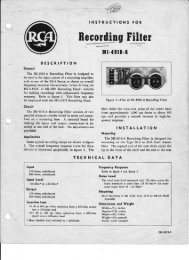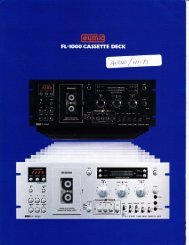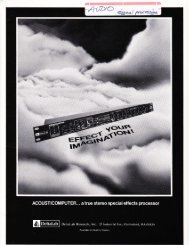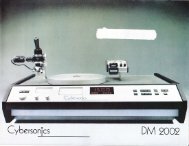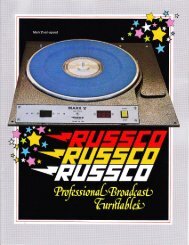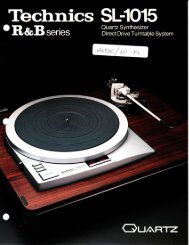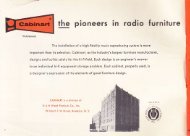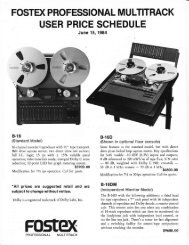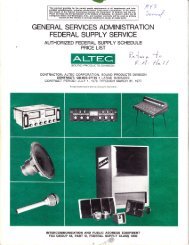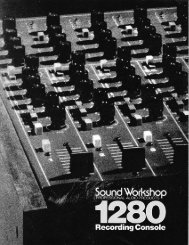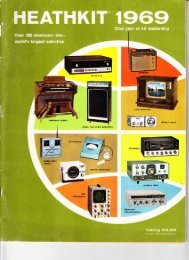Turner_1970_catalog1 - Preservation Sound
Turner_1970_catalog1 - Preservation Sound
Turner_1970_catalog1 - Preservation Sound
You also want an ePaper? Increase the reach of your titles
YUMPU automatically turns print PDFs into web optimized ePapers that Google loves.
How to choose a microphoneTo help you find the one best microphonefor your specific use, the catalogis divided into sections, as listed in thetable of contents on the opposite page.These sections are based on yourappl cation rather th an our d esig n.Within each section, the microphonesare individually different and these differencesare fully explained. There are,however, a number of basic pointsabout microphones in general whichmay be of help in your seleclion, andthese poinls are brielly covered in thefollowing parag raphs.SensingEvery microphone has a sensing element,or transducer, to convert soundvibrations into electrical signals. Somenic'ophones rave carbon interio rs.some ceramic, ribbon, capacitor, crystal,or dynamic. Each has a use and<strong>Turner</strong> manulactures almost every kind.Mlcrophones utilizing the moving coilprincipal are crassif:ed as dynamicmicrophones. This word is used toidentify the type of construction, hence,either omni-direclional or uni- d ireclionalTicrophones'nay be dyna mic.The moving coil construction producesrugged, dependable microphonescapable of smooih, peak free performance.For broadcast, slage, recordingand public address applications, adynamic microphone g e nerally provideslhe best combination of stability,fidelity, and ruggedness required. Forrnobile ard base station communicationssystems primarily involved withvoice lransmission, ceramic interiorso{fer good thermal and humidity stabilityand satisiactory response in thevoice frequency range. A crysial interioris similar in construction to aceramic offering slightly more outputlevel but is considerably more susceptibleto damage from physical abuseand temperature and humidity conditions.A carbon interior, similar to thoseused in telephones, oilers a ruggedinterior lor relatively low fidelity applications.Frequency ResponseFrequency response describes themanner in which a microphone responds.to sound that it is exposed to.N4icrophones are deslgned to cover aspecific response range with upperand lower frequency limits. Generallyspeaking, microphones are des gnedwith consideraiion glven to the frequencyresponse requirements of typicalapplicalions. For straight voicecommunication, a limited frequencyresponse range of 350 to 3,000 cyc esis pre{erred. For recording applications,often the frequency range mustbe extended to the limjts o1the averagehuman ear or lrom 40 or 50 Hz up to12 to 13,000 Hz. Recording of a symphonyorchestra would require use ofa microphone with an extended responserange of from 40 Hz up toperhaps 15,000 Hz. Generally, extensionof the lrequency range increasescost so there is no economic or audiovalue in using a microphone with agreater response range than you require.For good {ide1ily, the responseover the frequency range must be flat,with no distortion at either end. However,in many appliaations the frequencyresponse of a microphone mustbe tailored to fit the application andthis is taken into consideral a- - -:desigr o'tl-e ricropho-€: - '-:cataiog.Pick-up \-V crophones are des gleo i: :':. ::speci'ic directional cra.ac::' -'- : =Omn i-d irect'o.tal m c'opho-e-, :': - -crophones that are eqLa y s?-,: : . : :soulds arriving fror'r a oi'ecl ---: =-:uni-directional orcardioid m c': : - : -=iare designed to be more ser: .: -:sounds arriving from the f .oni ;- -- : i:serstve 10 sounds ariv ng [':- --:rear o' the r'ricrophone. For sc -: :performance situations cardioiC - :':-phones can be very helpf-l ^ e - -:-'-ing feedback howl and squeal r'. :- :caused by'he mjcrophones oicn -=--:audience, background, and sp::.:-noises and sending them throug- :-.system again. The cardioid or -::-shaped pick--p pattern elinina::-" - -greatly reduces ihe pick-up of sc--,-.arivi'rg f.om the rear of tr're r:-:-pl-o.le. Tl^e shaping of the p c,- - rpatterr is accomp'ished by intE'.'damping or baflles. Every sing le Tu'!ca'oio d m crophone is indiv.o-:resreo for 'ront-to-back discr r -=lioroefore leaving the facrory. ::-sponse curves are charted on ea:-m crophone's performance. lf both:-:fronl response and the cancellatjor :'sound arrlving from the rear do :::Teer spec 'icat ons. il is 'ejected ----rer does ^ot 'nake seconds (even '.-'prvaie labe s). All <strong>Turner</strong> productjcrJstpass ''gio q-ality cottrol reou :--errs oefo'e ii is a,lowed io ea.;our plani.lnput and Output[,4icrophones are a component parl:'an audio system and must be eleci'cal y compatlble with the other sysiecol-'rponenLsN,4icrophones co"le -low impedance (150 ohm) or high ,--pedance (40-50,000 ohm), or in co--binat ons of both. lt is very imporl.that you select a microphone with :Vp'oper in pedarce to malch the rr;cr:-phone inpJt 01 yoLr eqdipment. Ve-.of the microphones in thls catalog a-:



